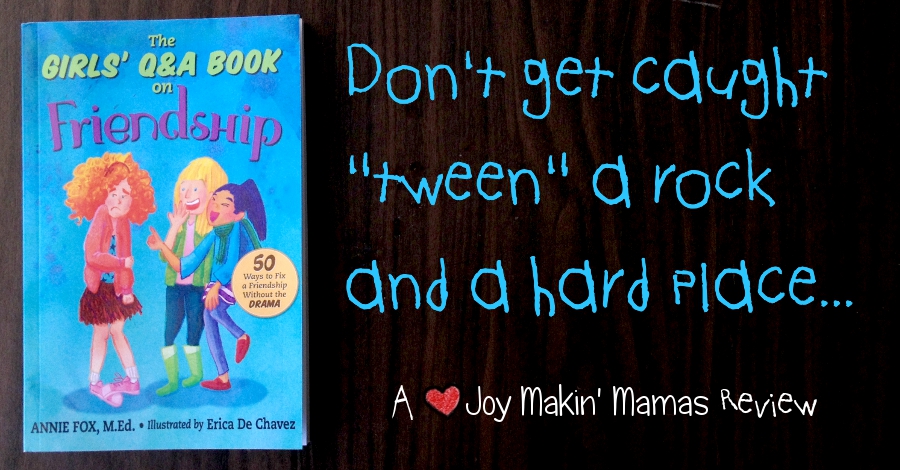 I remember my own “tween” years as being extremely confusing, emotional, and overly dramatic. Everyone I know who is currently raising a “tween” girl has mentioned that this stage of life is filled with drama at least once. So when I was contacted and asked if I’d like a review copy of The Girls’ Q&A Book on Friendship by Annie Fox M. Ed., I said yes. Yes, I would like to read anything that is meant to help girls find their path socially, with less drama and confusion.
I remember my own “tween” years as being extremely confusing, emotional, and overly dramatic. Everyone I know who is currently raising a “tween” girl has mentioned that this stage of life is filled with drama at least once. So when I was contacted and asked if I’d like a review copy of The Girls’ Q&A Book on Friendship by Annie Fox M. Ed., I said yes. Yes, I would like to read anything that is meant to help girls find their path socially, with less drama and confusion.
There is no question, at least for me, that the way girls interact with each other between the ages of 8 and 12 is distinct from the ways in which boys interact with each other. So, in my personal opinion, a guide for girls about being friends with other girls is called for at that stage. I’d be 100% against it if I felt it was perpetuating a double standard of behavior- one for boys and one for girls- but it really seems to me that it’s aimed at social differences, not holding girls to a different standard. (If you are parenting a girl or you disagree on some other basis, I’d love to hear your opinion. Of course, if you agree, I’d love to hear that too.)
Still, I wasn’t sure if I’d be able to do a helpful review of the book, even though my eldest (and I cannot believe we are here already) at 7, is on the cusp of the age group this book is meant for, because both of my kids are boys. Thank you, biology, for handing me an end-run around first hand experience with girl drama as a mom. I’ll consider it an apology for my terrible vision, etc.
My fears that I would need to call in reinforcements were unfounded. When I opened this book and started reading through the questions, I was transported back to my own “tween” years nearly as powerfully as if I’d time traveled there. Things I had forgotten years ago came immediately to mind as I read the questions- as did the feeling that I was the only one who didn’t understand what was going on in these situations. I remember thinking that there was a code that everyone understood but me, and thinking that the very questions posed in this book were “dumb.” I never asked most of them, even though my mom or any other trusted adult could probably have given me perfectly satisfactory, common sense answers. I think there is huge value in letting kids know that their experience is universal. It’s one thing to think you’re the only one who doesn’t know how to respond when a friend is kind to you when you’re alone, but bullies you when you are around other friends. It’s quite another to know that this is something that happens to everyone eventually. Just removing the “why ME?” aspect of the question is a powerful coping tool. I can remember personally experiencing nearly all of the scenarios in the book.
The sub-title “50 ways to fix a friendship without the drama” might cause you to be concerned that girls will be told they should always be able to “fix” a friendship. They won’t. Some of the “50 ways” include sensibly advising that it might be time to take a break and branch out. The book ends up being not so much about trying to fix “a friendship” as it is about building friendship and friend-making skills.
I do feel that the author has overused the words “nice” and “mean” in an effort to make the book relatable to this age group, but that’s a personal pet peeve. I don’t like when people use the word “nice” (which connotes people-pleasing at the expense of standing up for oneself) interchangeably with “kind,” which means treating people with compassion even when we don’t necessarily like them. “Mean” is just a word that I feel is overused and unspecific. As I say, that’s a pet peeve. I think most 8-12 year olds use and understand that vocabulary in this context.
The common-sense advice is illustrated with drawings by Erica De Chavez. Her bio says this is her first illustrated publication, but I would honestly have never guessed. The pictures are evocative, charming, and adorable. Personally, I love that they depict girls of differing ethnic backgrounds, physical abilities, styles of dress, and body types. Even better, she depicts them socializing together. I want to draw a thousand little hearts around all of them, as long as I’m hanging out here in my tween years, because she has done this in an effortless way that doesn’t feel forced. If there is a girl out there who wouldn’t see herself somewhere in these illustrations, I’d be surprised. In my opinion, this just hammers home the message that these experiences are universal.
Between the advice and the pictures, this book has managed, in just 133 well-organized pages, to remind the reader that while our individual experiences may differ, there are common threads that pull us all together. Annie Fox and Erica De Chavez set out to collaborate on a book about friendships, but what they’ve created is a book about community, and how we all exist and are important within it.



Caught “tween” a rock and hard place… http://t.co/8WRlO0OekZ @GirlDramaChat @PandaErica
Really awesome review of Annie’s new book, “The Girls Q&A Book on Friendship”: “Between the advice and the… http://t.co/GAWdig1ogq
.@joymakinmamas TY 4 UR enthusiastic review of The Girls’ Q&A Book on Friendship, Meghan! http://t.co/jcTnaHhRL3 U made my day, girl friend!
RT @Annie_Fox: .@joymakinmamas TY 4 UR enthusiastic review of The Girls’ Q&A Book on Friendship, Meghan! http://t.co/jcTnaHhRL3 U made my d…
RT @Annie_Fox: .@joymakinmamas TY 4 UR enthusiastic review of The Girls’ Q&A Book on Friendship, Meghan! http://t.co/jcTnaHhRL3 U made my d…
RT @joymakinmamas: Caught “tween” a rock and hard place… http://t.co/8WRlO0OekZ @GirlDramaChat @PandaErica
This seriously has to be the kindest and most thoughtful review yet!
“Annie Fox and Erica De Chavez set out to… http://t.co/LTKs7lg4cV
Blown away by this insightful review of The Girls’ Q&A Book on Friendship. So cool when an adult reviewer totally… http://t.co/Wfp1YQcoUF
RT @Annie_Fox: Blown away by this insightful review of The Girls’ Q&A Book on Friendship. So cool when an adult reviewer totally… http://…
RT @PandaErica: This seriously has to be the kindest and most thoughtful review yet!
“Annie Fox and Erica De Chavez set out to… http://t…
RT @DavidBFox: Really awesome review of Annie’s new book, “The Girls Q&A Book on Friendship”: “Between the advice and the… http://t.co/GA…
RT @PandaErica: This seriously has to be the kindest and most thoughtful review yet!
“Annie Fox and Erica De Chavez set out to… http://t…
RT @joymakinmamas: Caught “tween” a rock and hard place… http://t.co/8WRlO0OekZ @GirlDramaChat @PandaErica
RT @Annie_Fox: .@joymakinmamas TY 4 UR enthusiastic review of The Girls’ Q&A Book on Friendship, Meghan! http://t.co/jcTnaHhRL3 U made my d…
RT @DavidBFox: Really awesome review of Annie’s new book, “The Girls Q&A Book on Friendship”: “Between the advice and the… http://t.co/GA…
RT @PandaErica: This seriously has to be the kindest and most thoughtful review yet!
“Annie Fox and Erica De Chavez set out to… http://t…
RT @joymakinmamas: Caught “tween” a rock and hard place… http://t.co/8WRlO0OekZ @GirlDramaChat @PandaErica
RT @PandaErica: This seriously has to be the kindest and most thoughtful review yet!
“Annie Fox and Erica De Chavez set out to… http://t…
RT @DavidBFox: Really awesome review of Annie’s new book, “The Girls Q&A Book on Friendship”: “Between the advice and the… http://t.co/GA…
“When I opened this book I was transported back to my own tween yrs … as if I’d time traveled” http://t.co/jcTnaHhRL3 #GirlDramaChat
RT @joymakinmamas: It’s worth reading just for the illustrations by @PandaErica Check out my review: http://t.co/C278RjnJHx @GirlDramaChat